Nurture Creativity in Children: Professional Development Assessment
VerifiedAdded on 2020/09/17
|30
|5983
|64
Homework Assignment
AI Summary
This assignment delves into the multifaceted aspects of nurturing creativity in children and fostering an inclusive and respectful workplace. It begins with an exploration of the importance of self-awareness, cultural perspectives, and biases for managers and staff. The assessment then analyzes inclusive workplaces, strategies for promoting diversity and respect, and ensuring client safety. It covers verbal and non-verbal communication strategies, barriers to communication, and methods for overcoming language barriers. The assignment also discusses building client confidence, resolving conflicts, and the impact of community attitudes and workplace policies. Furthermore, it examines legal and ethical considerations related to discrimination and human rights, along with the influence of various social, political, and cultural factors on work and society. The document concludes with a discussion of diversity practices, their impact on behavior, and the importance of embracing resources that support diversity within organizations. The assignment is a comprehensive overview of key concepts in professional development and community service.
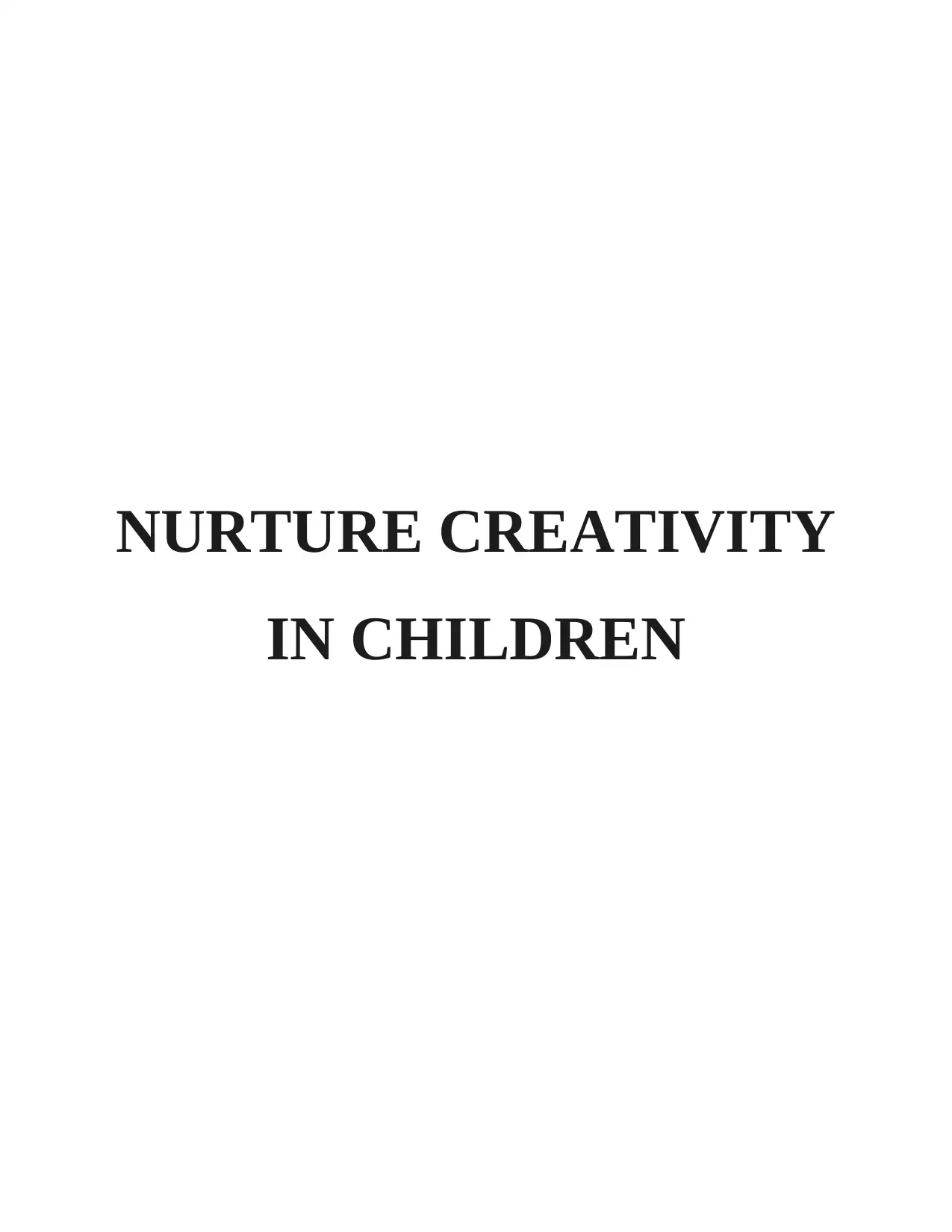
NURTURE CREATIVITY
IN CHILDREN
IN CHILDREN
Paraphrase This Document
Need a fresh take? Get an instant paraphrase of this document with our AI Paraphraser
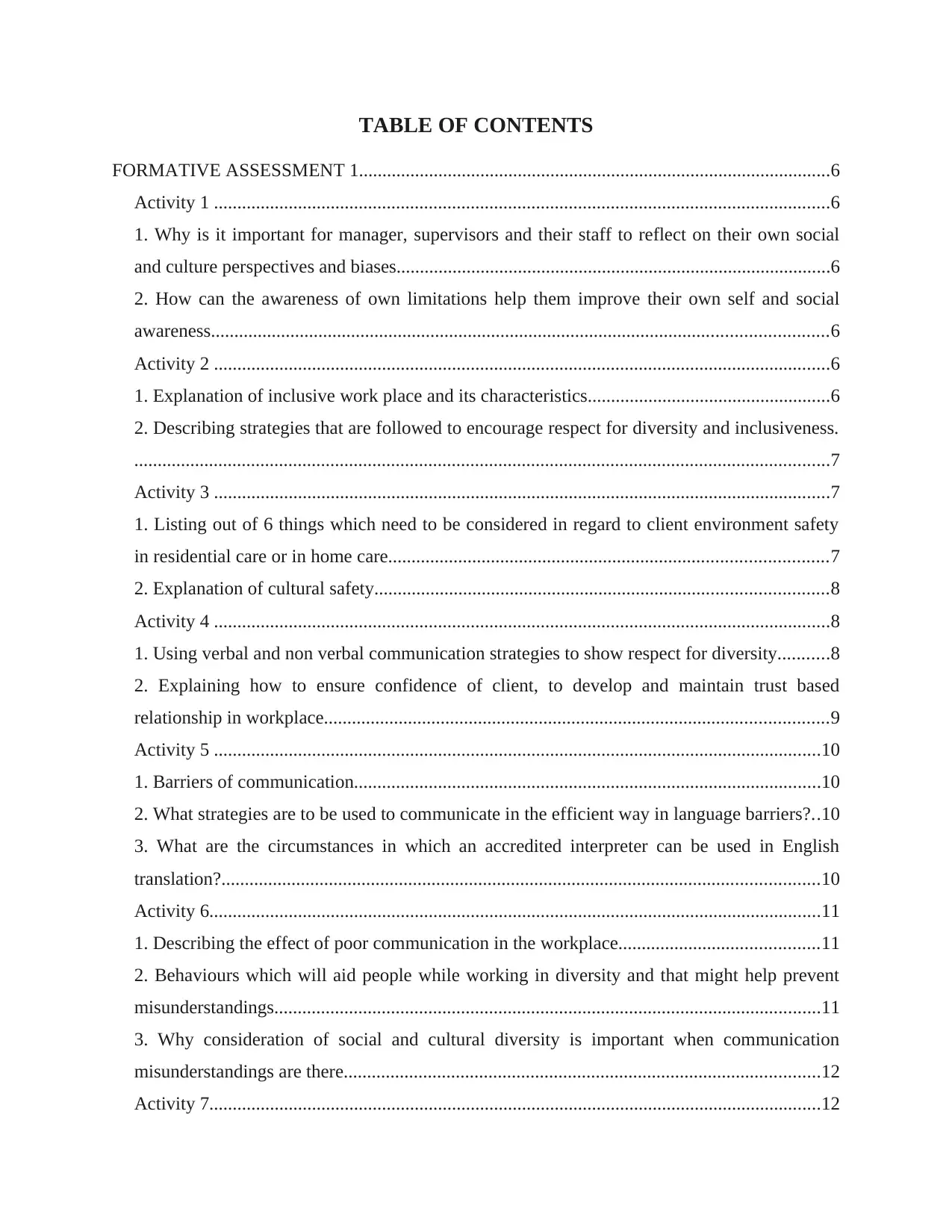
TABLE OF CONTENTS
FORMATIVE ASSESSMENT 1.....................................................................................................6
Activity 1 ....................................................................................................................................6
1. Why is it important for manager, supervisors and their staff to reflect on their own social
and culture perspectives and biases.............................................................................................6
2. How can the awareness of own limitations help them improve their own self and social
awareness....................................................................................................................................6
Activity 2 ....................................................................................................................................6
1. Explanation of inclusive work place and its characteristics....................................................6
2. Describing strategies that are followed to encourage respect for diversity and inclusiveness.
.....................................................................................................................................................7
Activity 3 ....................................................................................................................................7
1. Listing out of 6 things which need to be considered in regard to client environment safety
in residential care or in home care..............................................................................................7
2. Explanation of cultural safety.................................................................................................8
Activity 4 ....................................................................................................................................8
1. Using verbal and non verbal communication strategies to show respect for diversity...........8
2. Explaining how to ensure confidence of client, to develop and maintain trust based
relationship in workplace............................................................................................................9
Activity 5 ..................................................................................................................................10
1. Barriers of communication....................................................................................................10
2. What strategies are to be used to communicate in the efficient way in language barriers?..10
3. What are the circumstances in which an accredited interpreter can be used in English
translation?................................................................................................................................10
Activity 6...................................................................................................................................11
1. Describing the effect of poor communication in the workplace...........................................11
2. Behaviours which will aid people while working in diversity and that might help prevent
misunderstandings.....................................................................................................................11
3. Why consideration of social and cultural diversity is important when communication
misunderstandings are there......................................................................................................12
Activity 7...................................................................................................................................12
FORMATIVE ASSESSMENT 1.....................................................................................................6
Activity 1 ....................................................................................................................................6
1. Why is it important for manager, supervisors and their staff to reflect on their own social
and culture perspectives and biases.............................................................................................6
2. How can the awareness of own limitations help them improve their own self and social
awareness....................................................................................................................................6
Activity 2 ....................................................................................................................................6
1. Explanation of inclusive work place and its characteristics....................................................6
2. Describing strategies that are followed to encourage respect for diversity and inclusiveness.
.....................................................................................................................................................7
Activity 3 ....................................................................................................................................7
1. Listing out of 6 things which need to be considered in regard to client environment safety
in residential care or in home care..............................................................................................7
2. Explanation of cultural safety.................................................................................................8
Activity 4 ....................................................................................................................................8
1. Using verbal and non verbal communication strategies to show respect for diversity...........8
2. Explaining how to ensure confidence of client, to develop and maintain trust based
relationship in workplace............................................................................................................9
Activity 5 ..................................................................................................................................10
1. Barriers of communication....................................................................................................10
2. What strategies are to be used to communicate in the efficient way in language barriers?..10
3. What are the circumstances in which an accredited interpreter can be used in English
translation?................................................................................................................................10
Activity 6...................................................................................................................................11
1. Describing the effect of poor communication in the workplace...........................................11
2. Behaviours which will aid people while working in diversity and that might help prevent
misunderstandings.....................................................................................................................11
3. Why consideration of social and cultural diversity is important when communication
misunderstandings are there......................................................................................................12
Activity 7...................................................................................................................................12
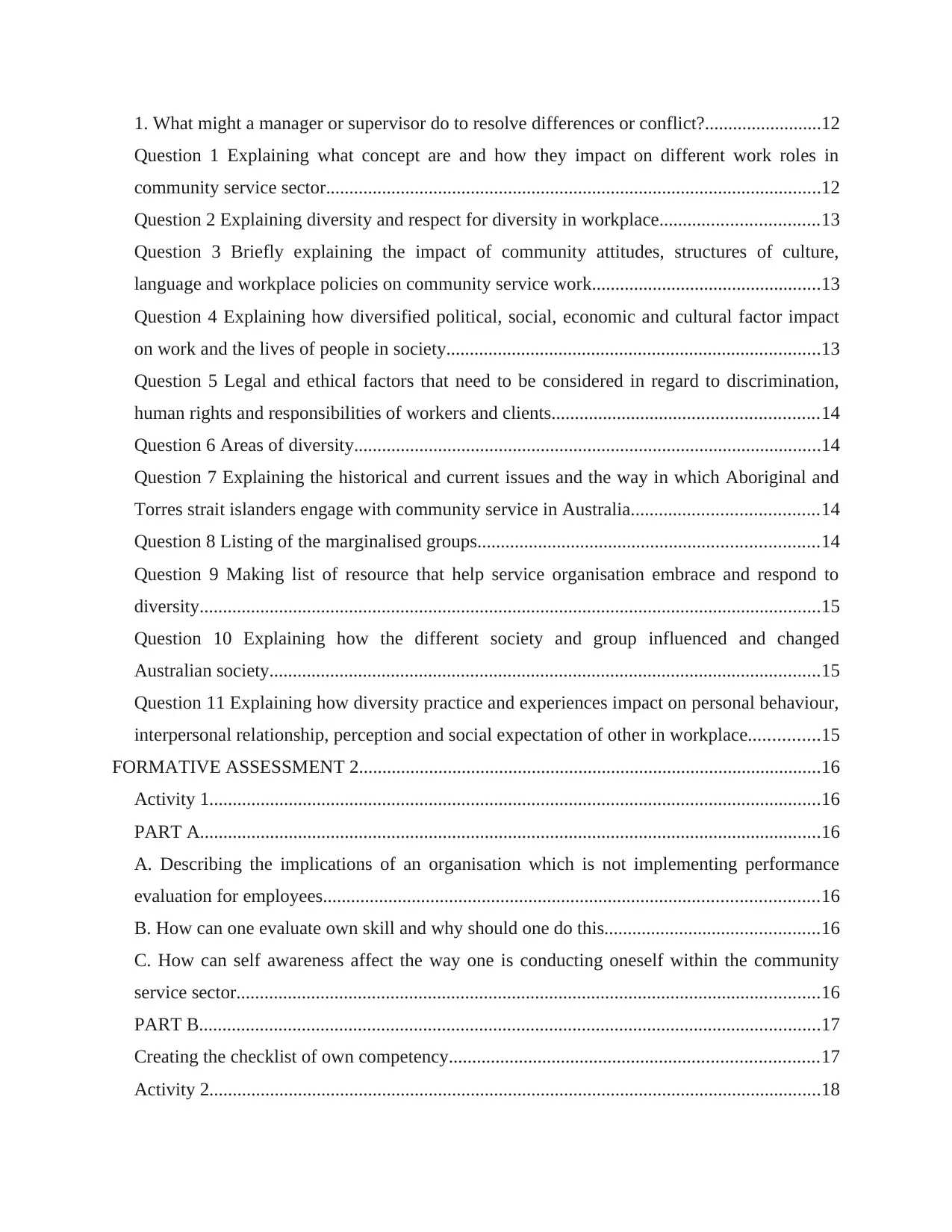
1. What might a manager or supervisor do to resolve differences or conflict?.........................12
Question 1 Explaining what concept are and how they impact on different work roles in
community service sector..........................................................................................................12
Question 2 Explaining diversity and respect for diversity in workplace..................................13
Question 3 Briefly explaining the impact of community attitudes, structures of culture,
language and workplace policies on community service work.................................................13
Question 4 Explaining how diversified political, social, economic and cultural factor impact
on work and the lives of people in society................................................................................13
Question 5 Legal and ethical factors that need to be considered in regard to discrimination,
human rights and responsibilities of workers and clients.........................................................14
Question 6 Areas of diversity....................................................................................................14
Question 7 Explaining the historical and current issues and the way in which Aboriginal and
Torres strait islanders engage with community service in Australia........................................14
Question 8 Listing of the marginalised groups.........................................................................14
Question 9 Making list of resource that help service organisation embrace and respond to
diversity.....................................................................................................................................15
Question 10 Explaining how the different society and group influenced and changed
Australian society......................................................................................................................15
Question 11 Explaining how diversity practice and experiences impact on personal behaviour,
interpersonal relationship, perception and social expectation of other in workplace...............15
FORMATIVE ASSESSMENT 2...................................................................................................16
Activity 1...................................................................................................................................16
PART A.....................................................................................................................................16
A. Describing the implications of an organisation which is not implementing performance
evaluation for employees..........................................................................................................16
B. How can one evaluate own skill and why should one do this..............................................16
C. How can self awareness affect the way one is conducting oneself within the community
service sector.............................................................................................................................16
PART B.....................................................................................................................................17
Creating the checklist of own competency...............................................................................17
Activity 2...................................................................................................................................18
Question 1 Explaining what concept are and how they impact on different work roles in
community service sector..........................................................................................................12
Question 2 Explaining diversity and respect for diversity in workplace..................................13
Question 3 Briefly explaining the impact of community attitudes, structures of culture,
language and workplace policies on community service work.................................................13
Question 4 Explaining how diversified political, social, economic and cultural factor impact
on work and the lives of people in society................................................................................13
Question 5 Legal and ethical factors that need to be considered in regard to discrimination,
human rights and responsibilities of workers and clients.........................................................14
Question 6 Areas of diversity....................................................................................................14
Question 7 Explaining the historical and current issues and the way in which Aboriginal and
Torres strait islanders engage with community service in Australia........................................14
Question 8 Listing of the marginalised groups.........................................................................14
Question 9 Making list of resource that help service organisation embrace and respond to
diversity.....................................................................................................................................15
Question 10 Explaining how the different society and group influenced and changed
Australian society......................................................................................................................15
Question 11 Explaining how diversity practice and experiences impact on personal behaviour,
interpersonal relationship, perception and social expectation of other in workplace...............15
FORMATIVE ASSESSMENT 2...................................................................................................16
Activity 1...................................................................................................................................16
PART A.....................................................................................................................................16
A. Describing the implications of an organisation which is not implementing performance
evaluation for employees..........................................................................................................16
B. How can one evaluate own skill and why should one do this..............................................16
C. How can self awareness affect the way one is conducting oneself within the community
service sector.............................................................................................................................16
PART B.....................................................................................................................................17
Creating the checklist of own competency...............................................................................17
Activity 2...................................................................................................................................18
⊘ This is a preview!⊘
Do you want full access?
Subscribe today to unlock all pages.

Trusted by 1+ million students worldwide
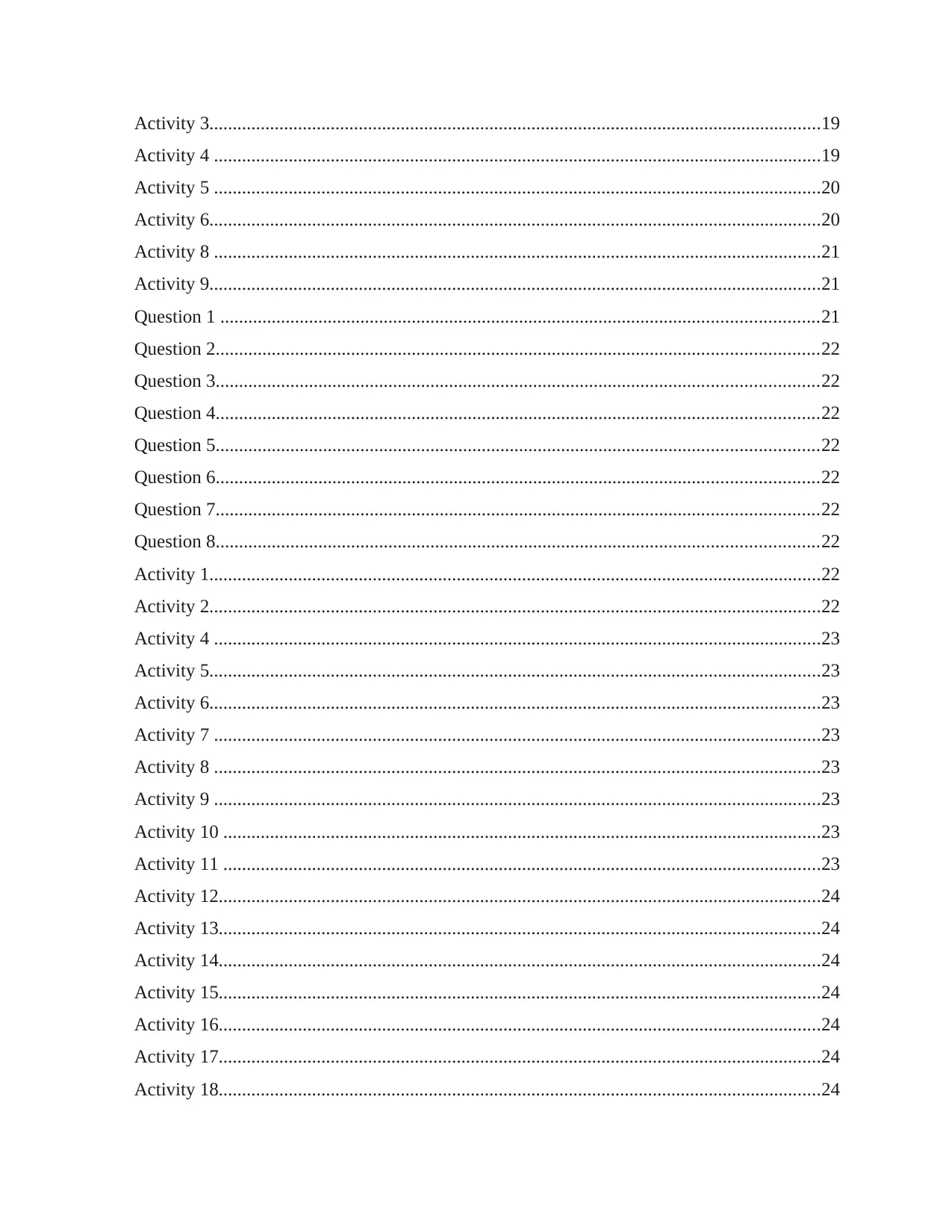
Activity 3...................................................................................................................................19
Activity 4 ..................................................................................................................................19
Activity 5 ..................................................................................................................................20
Activity 6...................................................................................................................................20
Activity 8 ..................................................................................................................................21
Activity 9...................................................................................................................................21
Question 1 ................................................................................................................................21
Question 2.................................................................................................................................22
Question 3.................................................................................................................................22
Question 4.................................................................................................................................22
Question 5.................................................................................................................................22
Question 6.................................................................................................................................22
Question 7.................................................................................................................................22
Question 8.................................................................................................................................22
Activity 1...................................................................................................................................22
Activity 2...................................................................................................................................22
Activity 4 ..................................................................................................................................23
Activity 5...................................................................................................................................23
Activity 6...................................................................................................................................23
Activity 7 ..................................................................................................................................23
Activity 8 ..................................................................................................................................23
Activity 9 ..................................................................................................................................23
Activity 10 ................................................................................................................................23
Activity 11 ................................................................................................................................23
Activity 12.................................................................................................................................24
Activity 13.................................................................................................................................24
Activity 14.................................................................................................................................24
Activity 15.................................................................................................................................24
Activity 16.................................................................................................................................24
Activity 17.................................................................................................................................24
Activity 18.................................................................................................................................24
Activity 4 ..................................................................................................................................19
Activity 5 ..................................................................................................................................20
Activity 6...................................................................................................................................20
Activity 8 ..................................................................................................................................21
Activity 9...................................................................................................................................21
Question 1 ................................................................................................................................21
Question 2.................................................................................................................................22
Question 3.................................................................................................................................22
Question 4.................................................................................................................................22
Question 5.................................................................................................................................22
Question 6.................................................................................................................................22
Question 7.................................................................................................................................22
Question 8.................................................................................................................................22
Activity 1...................................................................................................................................22
Activity 2...................................................................................................................................22
Activity 4 ..................................................................................................................................23
Activity 5...................................................................................................................................23
Activity 6...................................................................................................................................23
Activity 7 ..................................................................................................................................23
Activity 8 ..................................................................................................................................23
Activity 9 ..................................................................................................................................23
Activity 10 ................................................................................................................................23
Activity 11 ................................................................................................................................23
Activity 12.................................................................................................................................24
Activity 13.................................................................................................................................24
Activity 14.................................................................................................................................24
Activity 15.................................................................................................................................24
Activity 16.................................................................................................................................24
Activity 17.................................................................................................................................24
Activity 18.................................................................................................................................24
Paraphrase This Document
Need a fresh take? Get an instant paraphrase of this document with our AI Paraphraser

Question 1.................................................................................................................................24
Question 2 ................................................................................................................................24
Question 3 ................................................................................................................................24
Question 4 ................................................................................................................................24
Question 5.................................................................................................................................24
Question 6 ................................................................................................................................25
Question 7.................................................................................................................................25
REFERENCES..............................................................................................................................26
Books and journals:...................................................................................................................26
Online:.......................................................................................................................................26
Question 2 ................................................................................................................................24
Question 3 ................................................................................................................................24
Question 4 ................................................................................................................................24
Question 5.................................................................................................................................24
Question 6 ................................................................................................................................25
Question 7.................................................................................................................................25
REFERENCES..............................................................................................................................26
Books and journals:...................................................................................................................26
Online:.......................................................................................................................................26
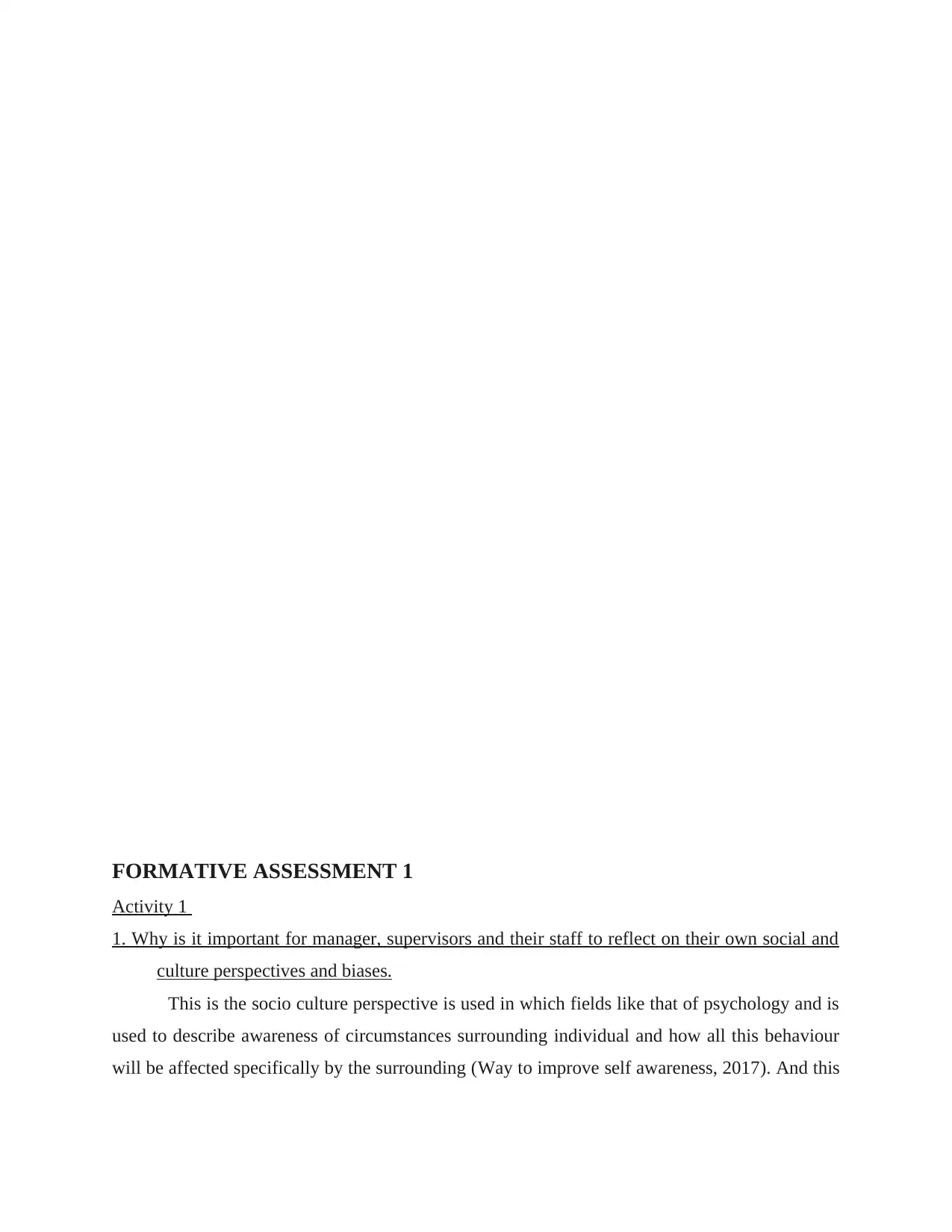
FORMATIVE ASSESSMENT 1
Activity 1
1. Why is it important for manager, supervisors and their staff to reflect on their own social and
culture perspectives and biases.
This is the socio culture perspective is used in which fields like that of psychology and is
used to describe awareness of circumstances surrounding individual and how all this behaviour
will be affected specifically by the surrounding (Way to improve self awareness, 2017). And this
Activity 1
1. Why is it important for manager, supervisors and their staff to reflect on their own social and
culture perspectives and biases.
This is the socio culture perspective is used in which fields like that of psychology and is
used to describe awareness of circumstances surrounding individual and how all this behaviour
will be affected specifically by the surrounding (Way to improve self awareness, 2017). And this
⊘ This is a preview!⊘
Do you want full access?
Subscribe today to unlock all pages.

Trusted by 1+ million students worldwide
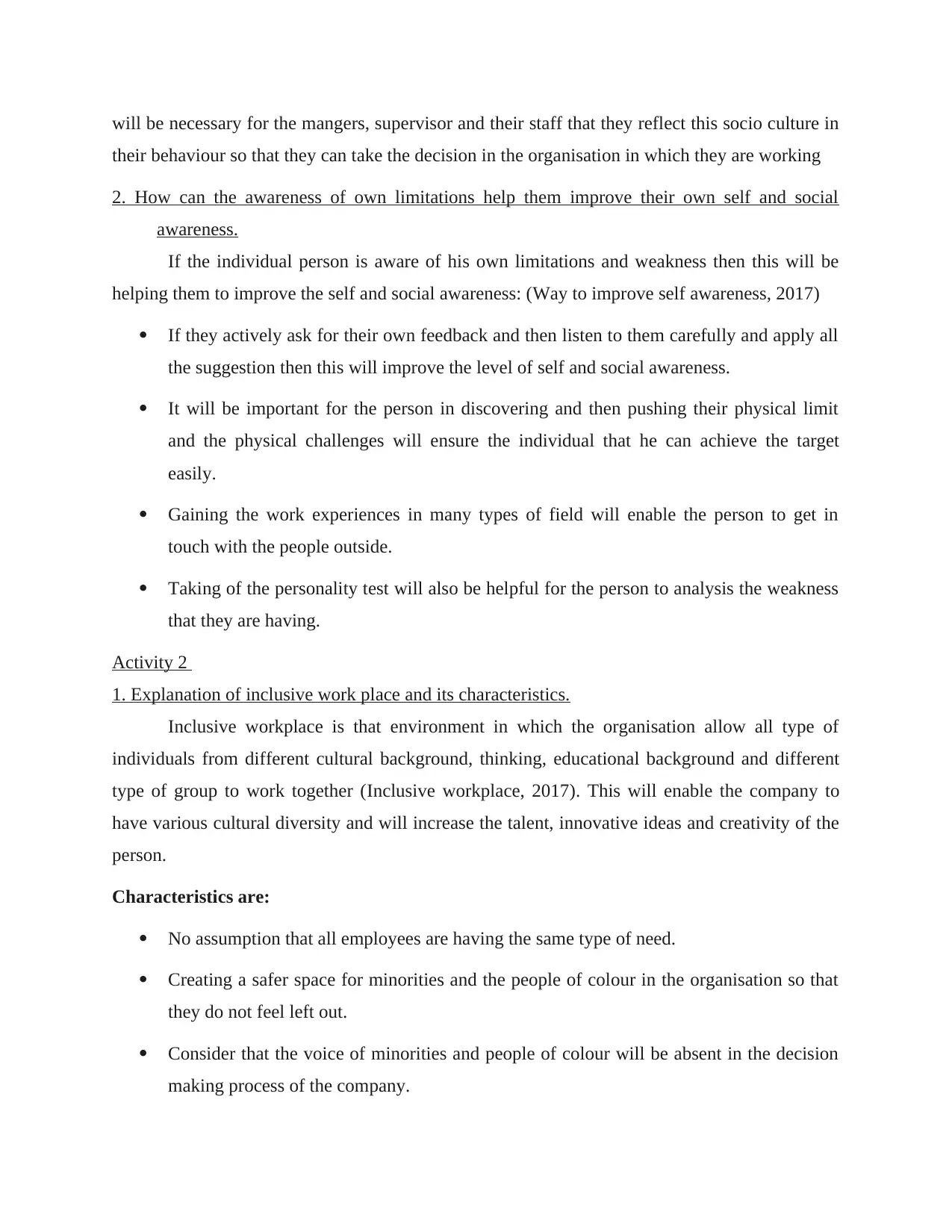
will be necessary for the mangers, supervisor and their staff that they reflect this socio culture in
their behaviour so that they can take the decision in the organisation in which they are working
2. How can the awareness of own limitations help them improve their own self and social
awareness.
If the individual person is aware of his own limitations and weakness then this will be
helping them to improve the self and social awareness: (Way to improve self awareness, 2017)
If they actively ask for their own feedback and then listen to them carefully and apply all
the suggestion then this will improve the level of self and social awareness.
It will be important for the person in discovering and then pushing their physical limit
and the physical challenges will ensure the individual that he can achieve the target
easily.
Gaining the work experiences in many types of field will enable the person to get in
touch with the people outside.
Taking of the personality test will also be helpful for the person to analysis the weakness
that they are having.
Activity 2
1. Explanation of inclusive work place and its characteristics.
Inclusive workplace is that environment in which the organisation allow all type of
individuals from different cultural background, thinking, educational background and different
type of group to work together (Inclusive workplace, 2017). This will enable the company to
have various cultural diversity and will increase the talent, innovative ideas and creativity of the
person.
Characteristics are:
No assumption that all employees are having the same type of need.
Creating a safer space for minorities and the people of colour in the organisation so that
they do not feel left out.
Consider that the voice of minorities and people of colour will be absent in the decision
making process of the company.
their behaviour so that they can take the decision in the organisation in which they are working
2. How can the awareness of own limitations help them improve their own self and social
awareness.
If the individual person is aware of his own limitations and weakness then this will be
helping them to improve the self and social awareness: (Way to improve self awareness, 2017)
If they actively ask for their own feedback and then listen to them carefully and apply all
the suggestion then this will improve the level of self and social awareness.
It will be important for the person in discovering and then pushing their physical limit
and the physical challenges will ensure the individual that he can achieve the target
easily.
Gaining the work experiences in many types of field will enable the person to get in
touch with the people outside.
Taking of the personality test will also be helpful for the person to analysis the weakness
that they are having.
Activity 2
1. Explanation of inclusive work place and its characteristics.
Inclusive workplace is that environment in which the organisation allow all type of
individuals from different cultural background, thinking, educational background and different
type of group to work together (Inclusive workplace, 2017). This will enable the company to
have various cultural diversity and will increase the talent, innovative ideas and creativity of the
person.
Characteristics are:
No assumption that all employees are having the same type of need.
Creating a safer space for minorities and the people of colour in the organisation so that
they do not feel left out.
Consider that the voice of minorities and people of colour will be absent in the decision
making process of the company.
Paraphrase This Document
Need a fresh take? Get an instant paraphrase of this document with our AI Paraphraser

2. Describing strategies that are followed to encourage respect for diversity and inclusiveness.
In the workplace the strategies of diversity is used to increase the number of minorities
and all the people from different culture and background (Inclusive workplace, 2017). All the
employee in the workplace should contribute to the development of work and professional
relationship which is supporting the diversity in workplace. The strategies which need to be
followed in order to encourage the respect for diversity and inclusiveness are:
Committing and boosting own cultural competency and self education is also important.
Seeking out of new perspective and ideas and thus creating that workplace which will be
valued and embraced in workplace
Treating all the person as they want to be treated and being sensitive to the boundaries of
expectation of others.
Observation of diverse traditions, celebrations and holidays from all the other different
type of culture prevailing in organisation. Encouraging the employee in getting involved
and then finding appropriate way in celebration of all traditions.
Building and embracing the working understanding of the people in workplace so that
they can positively contribute in culture of company.
Activity 3
1. Listing out of 6 things which need to be considered in regard to client environment safety in
residential care or in home care.
It is important that the workplace is safe for all the managers, supervisors, workers, client
and their family so that they can perform with any fear of getting injuries or hurt (Client
environment safety, 2017). Following are the things which need to be considered in regard to
client environment safety:
1. Providing safety of working conditions like safe floors, healthy food and procedures of
personal security while using electric equipments.
2. Providing adequate facilities like toilets, had washing, drinking water.
3. Daily monitoring of the working conditions and conducting home safety assessment.
In the workplace the strategies of diversity is used to increase the number of minorities
and all the people from different culture and background (Inclusive workplace, 2017). All the
employee in the workplace should contribute to the development of work and professional
relationship which is supporting the diversity in workplace. The strategies which need to be
followed in order to encourage the respect for diversity and inclusiveness are:
Committing and boosting own cultural competency and self education is also important.
Seeking out of new perspective and ideas and thus creating that workplace which will be
valued and embraced in workplace
Treating all the person as they want to be treated and being sensitive to the boundaries of
expectation of others.
Observation of diverse traditions, celebrations and holidays from all the other different
type of culture prevailing in organisation. Encouraging the employee in getting involved
and then finding appropriate way in celebration of all traditions.
Building and embracing the working understanding of the people in workplace so that
they can positively contribute in culture of company.
Activity 3
1. Listing out of 6 things which need to be considered in regard to client environment safety in
residential care or in home care.
It is important that the workplace is safe for all the managers, supervisors, workers, client
and their family so that they can perform with any fear of getting injuries or hurt (Client
environment safety, 2017). Following are the things which need to be considered in regard to
client environment safety:
1. Providing safety of working conditions like safe floors, healthy food and procedures of
personal security while using electric equipments.
2. Providing adequate facilities like toilets, had washing, drinking water.
3. Daily monitoring of the working conditions and conducting home safety assessment.
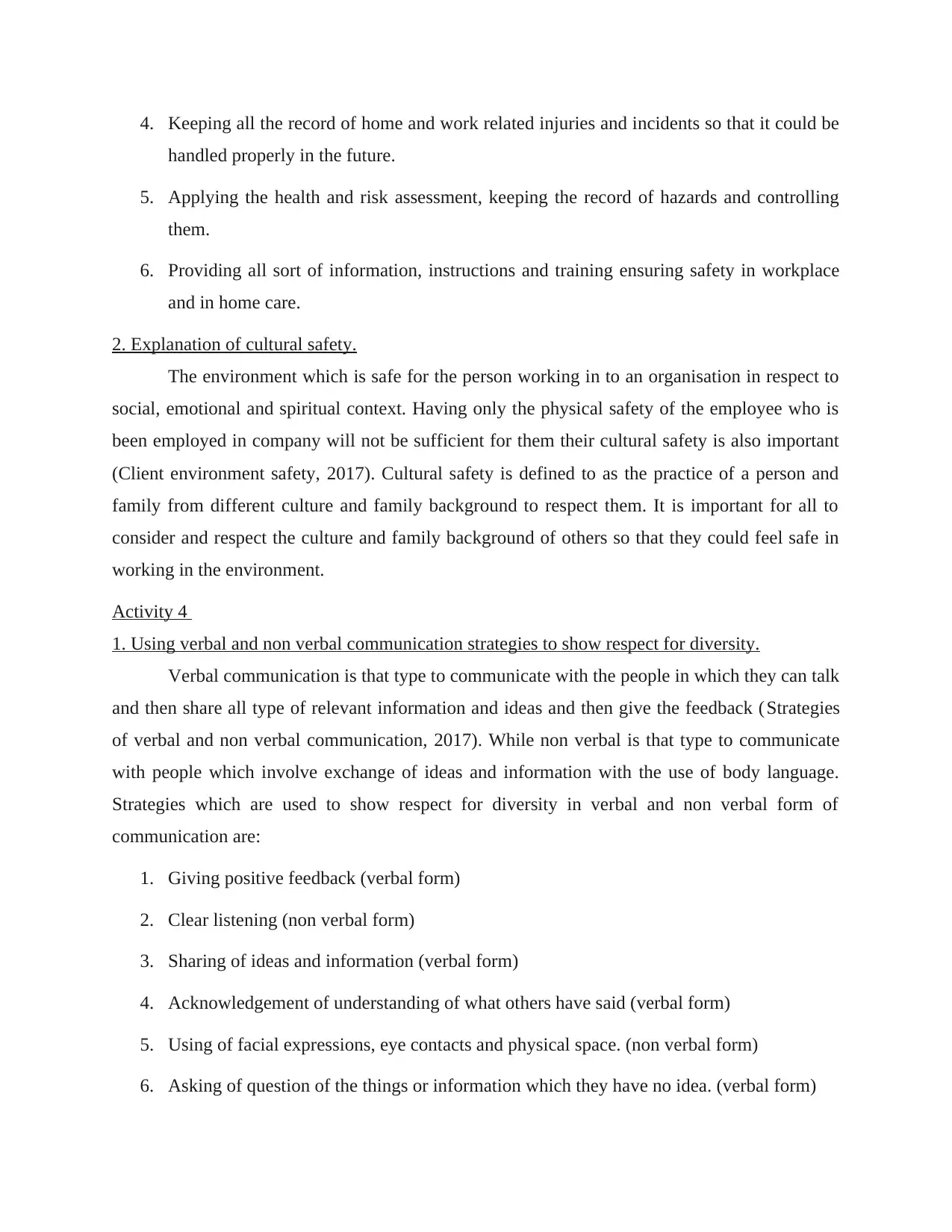
4. Keeping all the record of home and work related injuries and incidents so that it could be
handled properly in the future.
5. Applying the health and risk assessment, keeping the record of hazards and controlling
them.
6. Providing all sort of information, instructions and training ensuring safety in workplace
and in home care.
2. Explanation of cultural safety.
The environment which is safe for the person working in to an organisation in respect to
social, emotional and spiritual context. Having only the physical safety of the employee who is
been employed in company will not be sufficient for them their cultural safety is also important
(Client environment safety, 2017). Cultural safety is defined to as the practice of a person and
family from different culture and family background to respect them. It is important for all to
consider and respect the culture and family background of others so that they could feel safe in
working in the environment.
Activity 4
1. Using verbal and non verbal communication strategies to show respect for diversity.
Verbal communication is that type to communicate with the people in which they can talk
and then share all type of relevant information and ideas and then give the feedback (Strategies
of verbal and non verbal communication, 2017). While non verbal is that type to communicate
with people which involve exchange of ideas and information with the use of body language.
Strategies which are used to show respect for diversity in verbal and non verbal form of
communication are:
1. Giving positive feedback (verbal form)
2. Clear listening (non verbal form)
3. Sharing of ideas and information (verbal form)
4. Acknowledgement of understanding of what others have said (verbal form)
5. Using of facial expressions, eye contacts and physical space. (non verbal form)
6. Asking of question of the things or information which they have no idea. (verbal form)
handled properly in the future.
5. Applying the health and risk assessment, keeping the record of hazards and controlling
them.
6. Providing all sort of information, instructions and training ensuring safety in workplace
and in home care.
2. Explanation of cultural safety.
The environment which is safe for the person working in to an organisation in respect to
social, emotional and spiritual context. Having only the physical safety of the employee who is
been employed in company will not be sufficient for them their cultural safety is also important
(Client environment safety, 2017). Cultural safety is defined to as the practice of a person and
family from different culture and family background to respect them. It is important for all to
consider and respect the culture and family background of others so that they could feel safe in
working in the environment.
Activity 4
1. Using verbal and non verbal communication strategies to show respect for diversity.
Verbal communication is that type to communicate with the people in which they can talk
and then share all type of relevant information and ideas and then give the feedback (Strategies
of verbal and non verbal communication, 2017). While non verbal is that type to communicate
with people which involve exchange of ideas and information with the use of body language.
Strategies which are used to show respect for diversity in verbal and non verbal form of
communication are:
1. Giving positive feedback (verbal form)
2. Clear listening (non verbal form)
3. Sharing of ideas and information (verbal form)
4. Acknowledgement of understanding of what others have said (verbal form)
5. Using of facial expressions, eye contacts and physical space. (non verbal form)
6. Asking of question of the things or information which they have no idea. (verbal form)
⊘ This is a preview!⊘
Do you want full access?
Subscribe today to unlock all pages.

Trusted by 1+ million students worldwide
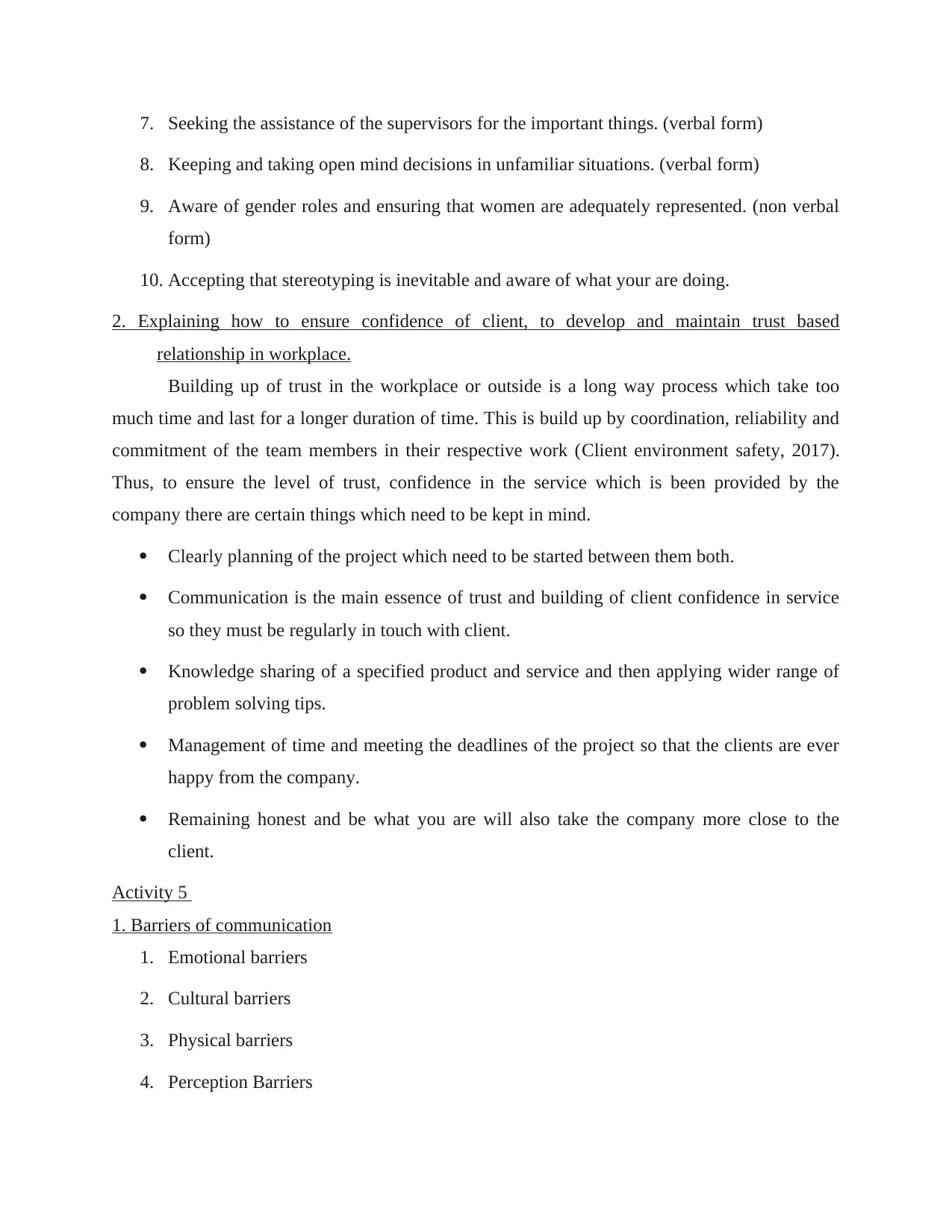
7. Seeking the assistance of the supervisors for the important things. (verbal form)
8. Keeping and taking open mind decisions in unfamiliar situations. (verbal form)
9. Aware of gender roles and ensuring that women are adequately represented. (non verbal
form)
10. Accepting that stereotyping is inevitable and aware of what your are doing.
2. Explaining how to ensure confidence of client, to develop and maintain trust based
relationship in workplace.
Building up of trust in the workplace or outside is a long way process which take too
much time and last for a longer duration of time. This is build up by coordination, reliability and
commitment of the team members in their respective work (Client environment safety, 2017).
Thus, to ensure the level of trust, confidence in the service which is been provided by the
company there are certain things which need to be kept in mind.
Clearly planning of the project which need to be started between them both.
Communication is the main essence of trust and building of client confidence in service
so they must be regularly in touch with client.
Knowledge sharing of a specified product and service and then applying wider range of
problem solving tips.
Management of time and meeting the deadlines of the project so that the clients are ever
happy from the company.
Remaining honest and be what you are will also take the company more close to the
client.
Activity 5
1. Barriers of communication
1. Emotional barriers
2. Cultural barriers
3. Physical barriers
4. Perception Barriers
8. Keeping and taking open mind decisions in unfamiliar situations. (verbal form)
9. Aware of gender roles and ensuring that women are adequately represented. (non verbal
form)
10. Accepting that stereotyping is inevitable and aware of what your are doing.
2. Explaining how to ensure confidence of client, to develop and maintain trust based
relationship in workplace.
Building up of trust in the workplace or outside is a long way process which take too
much time and last for a longer duration of time. This is build up by coordination, reliability and
commitment of the team members in their respective work (Client environment safety, 2017).
Thus, to ensure the level of trust, confidence in the service which is been provided by the
company there are certain things which need to be kept in mind.
Clearly planning of the project which need to be started between them both.
Communication is the main essence of trust and building of client confidence in service
so they must be regularly in touch with client.
Knowledge sharing of a specified product and service and then applying wider range of
problem solving tips.
Management of time and meeting the deadlines of the project so that the clients are ever
happy from the company.
Remaining honest and be what you are will also take the company more close to the
client.
Activity 5
1. Barriers of communication
1. Emotional barriers
2. Cultural barriers
3. Physical barriers
4. Perception Barriers
Paraphrase This Document
Need a fresh take? Get an instant paraphrase of this document with our AI Paraphraser
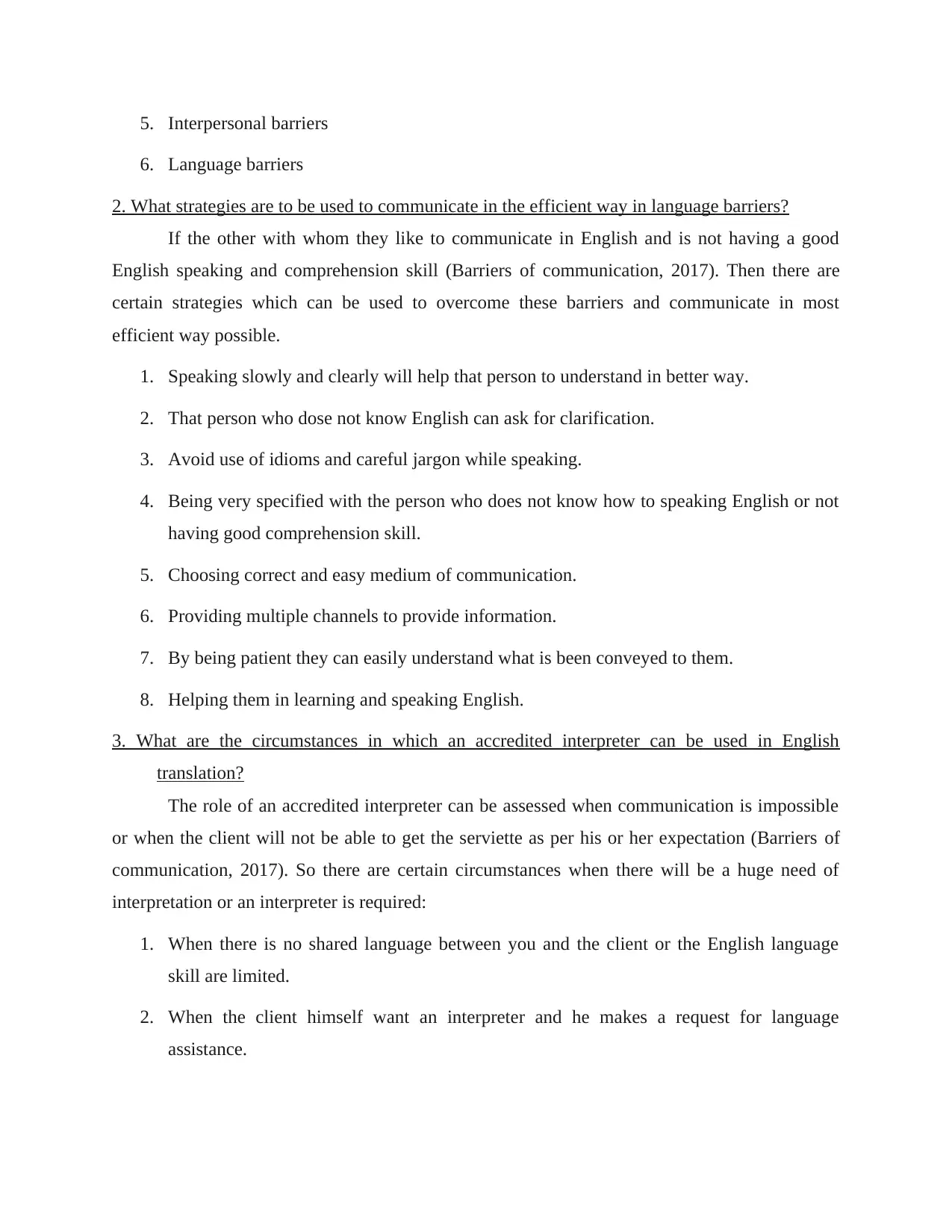
5. Interpersonal barriers
6. Language barriers
2. What strategies are to be used to communicate in the efficient way in language barriers?
If the other with whom they like to communicate in English and is not having a good
English speaking and comprehension skill (Barriers of communication, 2017). Then there are
certain strategies which can be used to overcome these barriers and communicate in most
efficient way possible.
1. Speaking slowly and clearly will help that person to understand in better way.
2. That person who dose not know English can ask for clarification.
3. Avoid use of idioms and careful jargon while speaking.
4. Being very specified with the person who does not know how to speaking English or not
having good comprehension skill.
5. Choosing correct and easy medium of communication.
6. Providing multiple channels to provide information.
7. By being patient they can easily understand what is been conveyed to them.
8. Helping them in learning and speaking English.
3. What are the circumstances in which an accredited interpreter can be used in English
translation?
The role of an accredited interpreter can be assessed when communication is impossible
or when the client will not be able to get the serviette as per his or her expectation (Barriers of
communication, 2017). So there are certain circumstances when there will be a huge need of
interpretation or an interpreter is required:
1. When there is no shared language between you and the client or the English language
skill are limited.
2. When the client himself want an interpreter and he makes a request for language
assistance.
6. Language barriers
2. What strategies are to be used to communicate in the efficient way in language barriers?
If the other with whom they like to communicate in English and is not having a good
English speaking and comprehension skill (Barriers of communication, 2017). Then there are
certain strategies which can be used to overcome these barriers and communicate in most
efficient way possible.
1. Speaking slowly and clearly will help that person to understand in better way.
2. That person who dose not know English can ask for clarification.
3. Avoid use of idioms and careful jargon while speaking.
4. Being very specified with the person who does not know how to speaking English or not
having good comprehension skill.
5. Choosing correct and easy medium of communication.
6. Providing multiple channels to provide information.
7. By being patient they can easily understand what is been conveyed to them.
8. Helping them in learning and speaking English.
3. What are the circumstances in which an accredited interpreter can be used in English
translation?
The role of an accredited interpreter can be assessed when communication is impossible
or when the client will not be able to get the serviette as per his or her expectation (Barriers of
communication, 2017). So there are certain circumstances when there will be a huge need of
interpretation or an interpreter is required:
1. When there is no shared language between you and the client or the English language
skill are limited.
2. When the client himself want an interpreter and he makes a request for language
assistance.
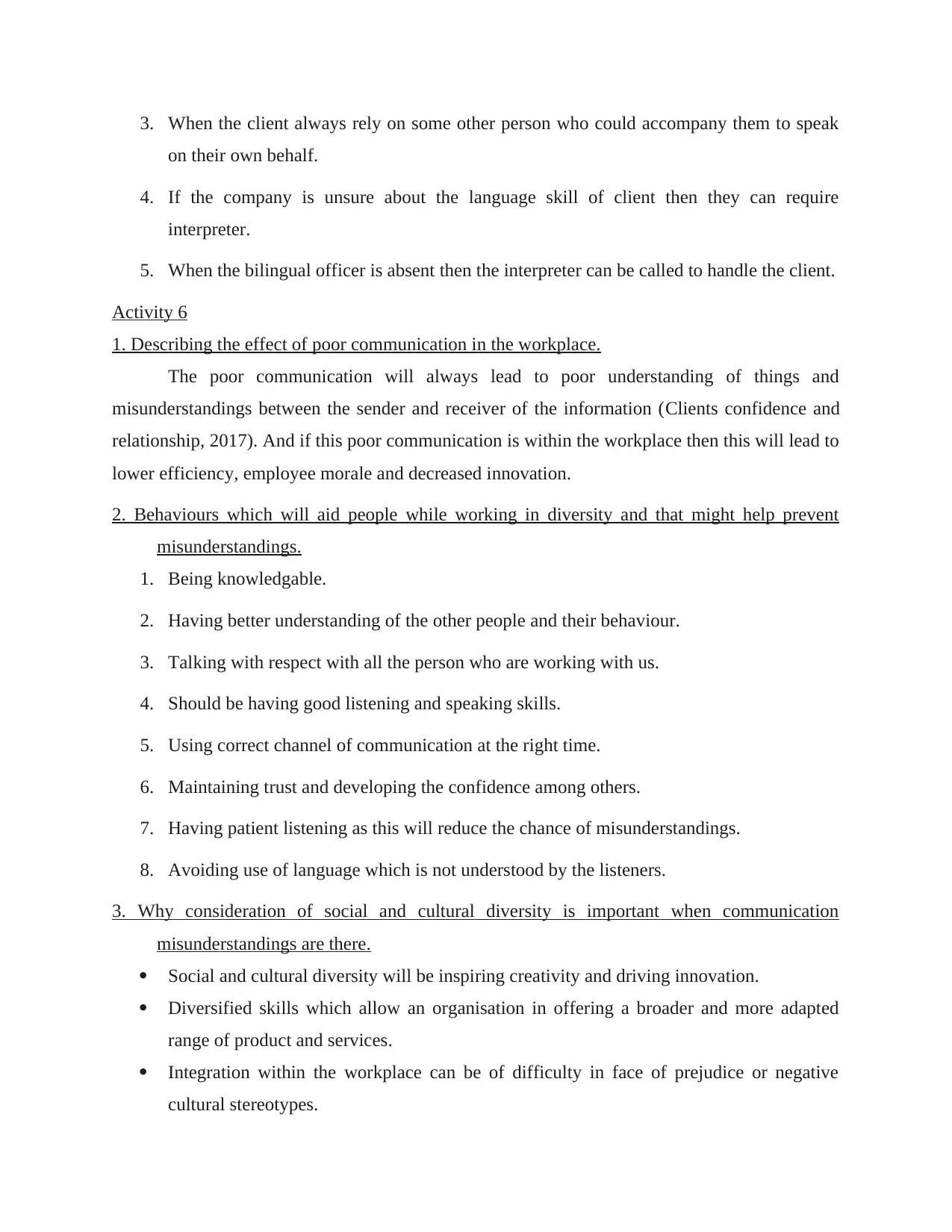
3. When the client always rely on some other person who could accompany them to speak
on their own behalf.
4. If the company is unsure about the language skill of client then they can require
interpreter.
5. When the bilingual officer is absent then the interpreter can be called to handle the client.
Activity 6
1. Describing the effect of poor communication in the workplace.
The poor communication will always lead to poor understanding of things and
misunderstandings between the sender and receiver of the information (Clients confidence and
relationship, 2017). And if this poor communication is within the workplace then this will lead to
lower efficiency, employee morale and decreased innovation.
2. Behaviours which will aid people while working in diversity and that might help prevent
misunderstandings.
1. Being knowledgable.
2. Having better understanding of the other people and their behaviour.
3. Talking with respect with all the person who are working with us.
4. Should be having good listening and speaking skills.
5. Using correct channel of communication at the right time.
6. Maintaining trust and developing the confidence among others.
7. Having patient listening as this will reduce the chance of misunderstandings.
8. Avoiding use of language which is not understood by the listeners.
3. Why consideration of social and cultural diversity is important when communication
misunderstandings are there.
Social and cultural diversity will be inspiring creativity and driving innovation.
Diversified skills which allow an organisation in offering a broader and more adapted
range of product and services.
Integration within the workplace can be of difficulty in face of prejudice or negative
cultural stereotypes.
on their own behalf.
4. If the company is unsure about the language skill of client then they can require
interpreter.
5. When the bilingual officer is absent then the interpreter can be called to handle the client.
Activity 6
1. Describing the effect of poor communication in the workplace.
The poor communication will always lead to poor understanding of things and
misunderstandings between the sender and receiver of the information (Clients confidence and
relationship, 2017). And if this poor communication is within the workplace then this will lead to
lower efficiency, employee morale and decreased innovation.
2. Behaviours which will aid people while working in diversity and that might help prevent
misunderstandings.
1. Being knowledgable.
2. Having better understanding of the other people and their behaviour.
3. Talking with respect with all the person who are working with us.
4. Should be having good listening and speaking skills.
5. Using correct channel of communication at the right time.
6. Maintaining trust and developing the confidence among others.
7. Having patient listening as this will reduce the chance of misunderstandings.
8. Avoiding use of language which is not understood by the listeners.
3. Why consideration of social and cultural diversity is important when communication
misunderstandings are there.
Social and cultural diversity will be inspiring creativity and driving innovation.
Diversified skills which allow an organisation in offering a broader and more adapted
range of product and services.
Integration within the workplace can be of difficulty in face of prejudice or negative
cultural stereotypes.
⊘ This is a preview!⊘
Do you want full access?
Subscribe today to unlock all pages.

Trusted by 1+ million students worldwide
1 out of 30
Related Documents
Your All-in-One AI-Powered Toolkit for Academic Success.
+13062052269
info@desklib.com
Available 24*7 on WhatsApp / Email
![[object Object]](/_next/static/media/star-bottom.7253800d.svg)
Unlock your academic potential
Copyright © 2020–2025 A2Z Services. All Rights Reserved. Developed and managed by ZUCOL.





